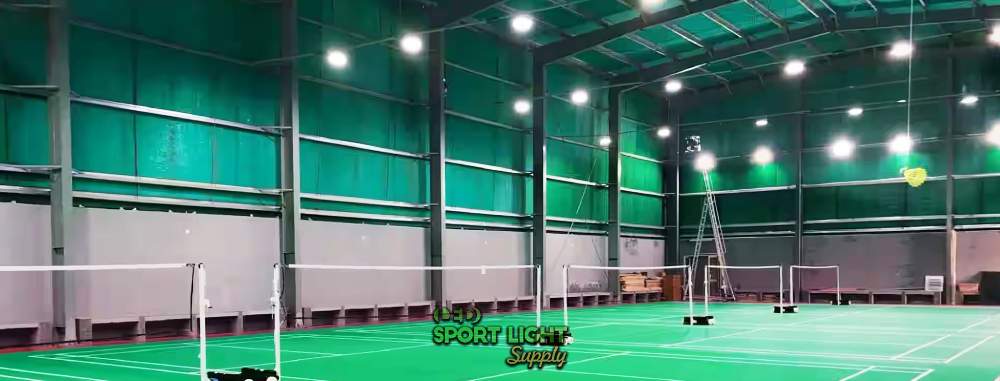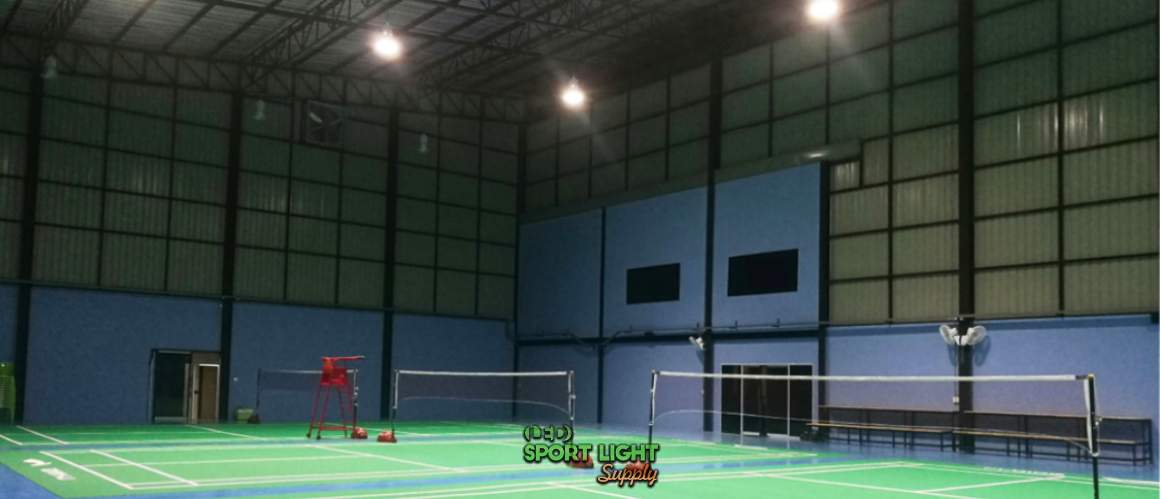Lighting is the unsung hero of a top-notch badminton court, transforming the playing experience and ensuring player safety. Imagine a game where every move is crystal clear, from the shuttlecock’s swift flight to the precise court lines and surroundings. This level of visibility is made possible with proper illumination. Enter LED lighting technology, a game-changer for badminton courts. Not only do LEDs provide the perfect lighting conditions, but they also offer impressive energy efficiency and cost savings.
Badminton is a fast-paced sport that demands quick reflexes and sharp vision. Proper lighting is essential for players to accurately track the shuttlecock and react swiftly to shots. Inadequate lighting can lead to poor visibility, increasing the risk of injuries and diminishing the overall playing experience. Therefore, ensuring that badminton courts are well-lit is paramount for both safety and performance.
Table of Contents
ToggleLED lighting has revolutionized the way sports facilities are illuminated, and badminton courts are no exception. LEDs offer numerous benefits that make them the ideal choice for badminton court lighting
One of the most compelling advantages of LED lighting is its remarkable energy efficiency. LEDs consume significantly less power compared to traditional lighting solutions such as incandescent or fluorescent bulbs. This efficiency is achieved through advanced technology that converts a higher percentage of electricity into visible light, rather than heat. For badminton courts, this translates to substantial reductions in energy consumption and, consequently, lower energy bills. The economic benefits are complemented by environmental advantages, as lower energy usage means a smaller carbon footprint. In an era where sustainability is increasingly important, switching to LED lighting is a practical step towards greener, more eco-friendly sports facilities.

LED lights are known for their exceptional longevity. Whereas conventional bulbs may last only a few thousand hours, high-quality LED fixtures can operate for 120,000 hours or more. This extended lifespan significantly reduces the frequency of bulb replacements and associated maintenance costs. For badminton courts, this means fewer disruptions and consistently high-quality lighting over long periods. Facility managers can thus allocate resources more efficiently, focusing on enhancing the overall player experience rather than dealing with frequent lighting maintenance issues.
Traditional lighting systems often require a warm-up period before reaching full brightness, which can be inconvenient in sports settings where immediate, reliable illumination is essential. LED lights, on the other hand, provide instant on/off capabilities. This feature is particularly beneficial for badminton courts, where lighting needs to be instantly responsive to accommodate scheduled matches and training sessions. The ability to achieve full brightness without delay enhances operational efficiency and ensures that the court is always ready for play.
The high lumen output of LED lights ensures that badminton courts are brightly and uniformly illuminated. This level of brightness is crucial for player performance, as it enhances visibility, allowing athletes to track the shuttlecock and react quickly to their opponent’s moves. The intense illumination provided by LEDs creates a vibrant playing environment, reducing eye strain and helping players maintain focus throughout the match. Whether for amateur players or professional athletes, the superior visibility afforded by high lumen output is a significant advantage.
One of the standout features of LED lighting is its ability to provide directional illumination. Unlike traditional bulbs, which emit light in all directions, LEDs can be engineered to focus light precisely where it is needed. For badminton courts, this means that lighting can be strategically positioned to ensure even coverage across the entire playing surface while minimizing light spillage into non-essential areas. This precision not only enhances lighting efficiency but also helps in reducing light pollution, particularly for outdoor courts. By directing light exactly where it is needed, LEDs maximize both energy efficiency and lighting effectiveness, creating an optimal environment for both players and spectators.
While the principles of good lighting apply to both indoor and outdoor badminton courts, there are key differences to consider. Indoor courts benefit from controlled environments, which means lighting can be more easily managed without external factors like weather. LED lights for indoor courts are typically installed at high bay positions to ensure even coverage and minimize shadows. Glare control and color temperature play significant roles indoors to create a comfortable and visually clear playing environment.
Outdoor courts, however, must contend with natural light variations and weather conditions. LEDs used for outdoor courts need to be more robust, weather-resistant, and capable of operating in various climates. Additionally, outdoor lighting often requires higher illumination levels to compete with or complement natural daylight. The fixtures must also minimize light pollution and spillage, ensuring that the light is directed precisely onto the court without disturbing the surrounding environment.

To create an optimal playing environment, badminton courts must meet specific lighting requirements. These requirements are designed to ensure uniform illumination, minimize glare, and provide adequate visibility for players and spectators.
The illuminance level, measured in lux, is a critical factor in badminton court lighting. For recreational play, a minimum of 300 lux is recommended, while professional courts should aim for at least 500 lux. Higher illuminance levels enhance visibility, allowing players to track the shuttlecock with ease and react swiftly to shots.
Uniformity in lighting is essential to avoid areas of shadow and uneven brightness across the court. A uniformity ratio of 0.7 or higher is ideal, meaning the light distribution should be consistent, with no significant variations in brightness. This uniformity ensures that players can maintain their focus and performance without being distracted by fluctuating light levels.
The color temperature of lighting affects the ambiance and visibility on the court. A color temperature of 4000K to 6500K is recommended for badminton courts. This range provides a cool, daylight-like illumination that enhances clarity and reduces eye strain, creating an optimal environment for players.
Glare can be a significant issue in sports lighting, as it can cause discomfort and impair visibility. Properly designed LED fixtures with glare control features, such as diffusers and lenses, help to minimize glare and create a comfortable playing environment. Positioning the lights at appropriate angles also reduces the risk of direct glare.
The placement of lights is crucial to achieving uniform illumination and minimizing shadows. Lights should be installed at a height of around 6 to 8 meters above the court surface, evenly distributed along the length and width of the court. This arrangement ensures that the entire playing area is well-lit without creating dark spots or areas of excessive brightness.
The number of lighting fixtures required depends on the size of the court and the desired illuminance level. A typical badminton court may require between 8 to 12 LED fixtures to achieve the recommended lighting standards. It is essential to calculate the total lumen output needed and distribute the fixtures accordingly to maintain uniformity.
Choosing the right type of LED fixtures is essential for achieving the desired lighting quality. High bay LED lights are commonly used for indoor badminton courts due to their high lumen output and excellent uniformity. These fixtures can be equipped with reflectors and diffusers to control light distribution and minimize glare.
The Color Rendering Index (CRI) measures the ability of a light source to accurately reproduce colors. A high CRI (80 or above) is recommended for badminton courts to ensure that colors appear natural and vibrant. This feature is particularly important for players to distinguish between the shuttlecock, court lines, and surrounding environment.
Proper installation and maintenance of LED lighting systems are crucial for ensuring long-term performance and reliability
During installation, it is essential to follow the manufacturer’s guidelines and industry standards. Proper wiring, secure mounting, and correct positioning of fixtures are vital to achieving the desired lighting quality. Engaging professional electricians with experience in sports facility lighting can ensure a successful installation.
LED lights require minimal maintenance compared to traditional lighting solutions. However, regular inspections and cleaning are necessary to maintain optimal performance. Dust and debris can accumulate on fixtures, reducing their efficiency and light output. Periodic cleaning and inspection help to ensure consistent illumination and extend the lifespan of the lights.
As technology advances, upgrading and retrofitting existing lighting systems with the latest LED solutions can further enhance performance and energy efficiency. Retrofitting involves replacing outdated fixtures with new LED fixtures without the need for extensive rewiring or modifications. This approach allows sports facilities to benefit from the latest advancements in lighting technology without significant disruptions.
Beyond the immediate advantages of improved visibility and player performance, LED lighting offers significant environmental and economic benefits for badminton courts.
LED lights consume less energy than traditional lighting systems, resulting in substantial energy savings. Reduced energy consumption not only lowers operational costs but also contributes to environmental sustainability by decreasing greenhouse gas emissions.
The long lifespan of LED lights reduces the frequency of replacements, leading to less waste and a lower carbon footprint. Additionally, LED lights do not contain hazardous materials like mercury, making them safer for disposal and recycling.
While the initial investment in LED lighting may be higher than traditional lighting, the long-term cost savings outweigh the upfront costs. Reduced energy bills, lower maintenance expenses, and fewer replacements contribute to the overall cost-effectiveness of LED lighting solutions.
Proper lighting is essential for creating a safe and enjoyable badminton playing environment. LED lighting offers numerous advantages, including energy efficiency, long lifespan, and high-quality illumination, making it the ideal choice for badminton courts. By understanding the specific lighting requirements and design considerations, sports facility managers can ensure that their badminton courts are well-lit, enhancing player performance and experience. Investing in LED lighting not only improves the quality of play but also provides significant environmental and economic benefits, making it a win-win solution for all.
Drop us a line to receive a free lighting design